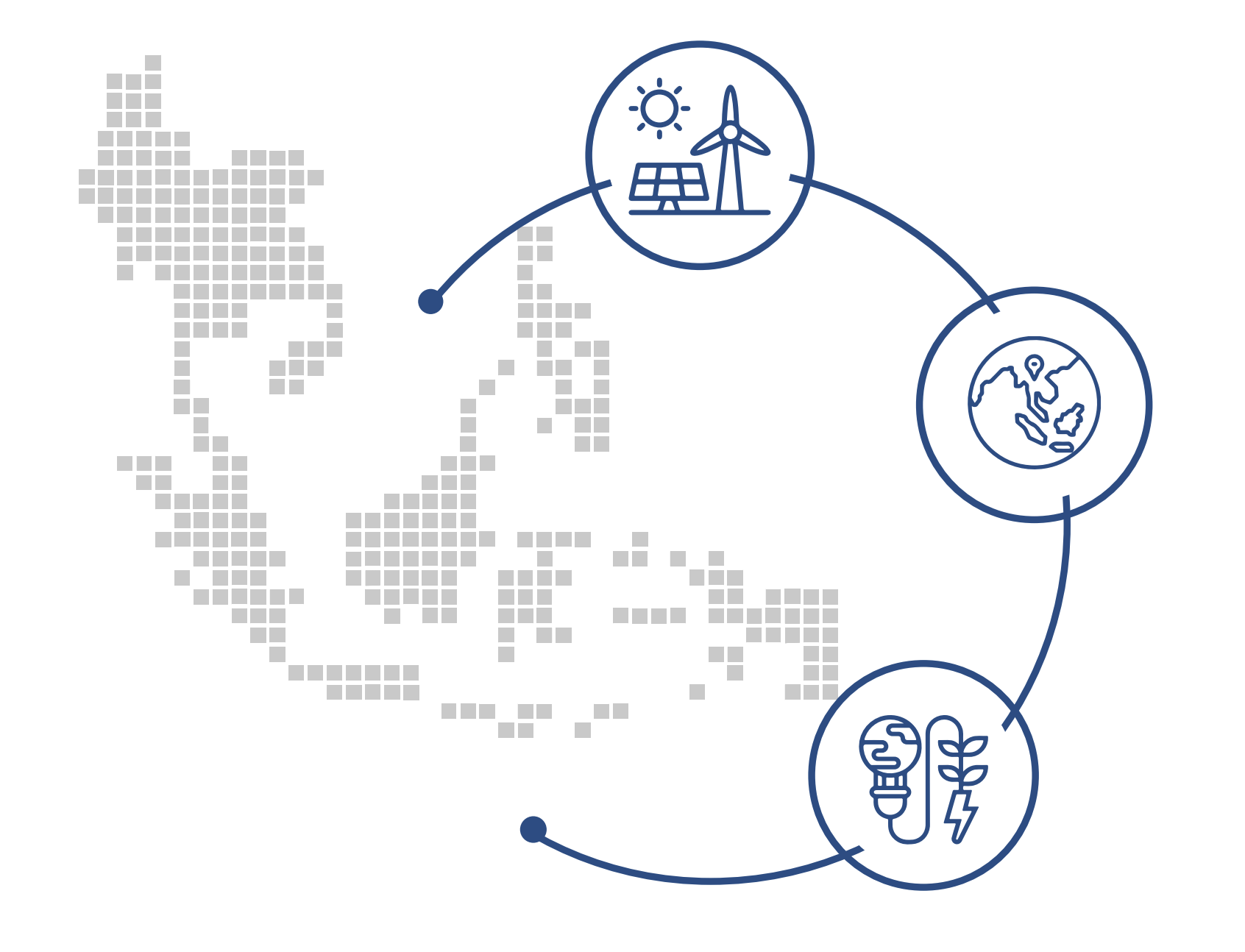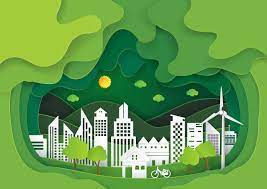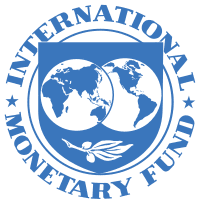Background
Senegal is located on the Atlantic coast in West Africa. Senegal has nearly 15 million inhabitants, where an estimated 40 percent are between 0 and 14 years old. It sits on the border of the Sahara desert and the Sub-Saharan forests. The mix of oceanic, arid and humid climates results in a variety of ecosystems throughout Senegal’s territories. Agricultural products account for 20 per cent of the country’s total merchandise exports. The fishery sector also plays an important role in Senegal’s economy by generating about 100,000 direct jobs. Much of the land is threatened by desertification due to overgrazing, deforestation and soil erosion from over-cultivation. With approximately 50% of its territory classified as semi-arid, the country is especially vulnerable to climate change, which is expected to intensify environmental threats such as desertification and water scarcity
The sectorial decomposition of GDP in 2017 was as follows: agriculture represented 16.9%, industry 24.3% and services 58.8%. It is interesting to note that in 2007, 77.5% of the labor force worked in agriculture. The modeled ILO estimates suggest that in 2018, 54% of the labor force was employed in services, while those working in agriculture represented 32%. This shows that Senegal is rapidly undergoing a structural transformation, which entails large-scale transfer of resources and labor force from one sector to the other. Along other African countries, Senegal is part of those that are experiencing a new pattern of structural change, where services exports have grown faster than merchandise exports, and vibrant ICT-based services sectors are developing as well as agro-industries, such as horticulture [1]. Rural areas are witnessing job reallocation out of the primary sector, as households diversify their livelihood and the rural non-farm economy develops.
In recent years, Senegal has also made important commercial discoveries of natural gas and oil. On the basis of 2015 estimates, these discoveries would make Senegal the world’s 40th largest oil producer and 20th largest gas producer. Since 2015, even larger reserves have been discovered off-shore which are likely to make oil and gas a much more important part of the economy. Production of oil and gas is expected to start in 2022.These developments have triggered much discussion in the country on the potential opportunities and risks associated with such discoveries. A High Council on Social Dialogue, which gathers representatives from all professional sectors, has been mandated by the President of Senegal to play a central role in the national dialogue around oil and gas in the country. Since then Senegal has launched a number of key strategies including the creation of the first oil and gas training school, the National Petroleum Institute (INPG) and the signature of key cooperation agreement with Mauritania on the Grand Tortue Ahmeyim (GTA) project, the gas field unveiled by Kosmos Energy in 2014 containing around 15 trillion cubic feet of gas. The SNE oil field, located 100km off the coast of Dakar is planned to be developed in phases. The final investment decision for phase one is expected by late 2019, while the drilling of production wells is scheduled to be commenced in 2021, which consist of 18 wells with another eight wells optional during a 3-4-year campaign. Phase one will be designed to allow subsequent SNE development phases, including options for potential gas export to shore and also for future subsea tiebacks from other reservoirs and fields [2].
Senegal seeks to put together a strong institutional and regulatory framework with the objective of developing the industry by attracting international investment while ensuring benefits return to the national citizens [3].
In 2008, Senegal led the “Great Green Wall” (GGW) project. Along with ten other African states, the mission involved planting trees from Dakar to Djibouti, over a 7,600-km long and 15-km wide strip. In the last six years, in Senegal, a total of 75 direct jobs and 1,800 indirect jobs, including in the nurseries sector and multipurpose gardens, have been created through the GGW, according to official statistics [4]. In addition, desertification in Senegal has slashed 34% of its area; the GGW has since ‘recovered’ just over 40,000 hectares out of the 817,500 hectares planned for the project.
The country also created a “Green Bank” to lend money with lower interest rates to farmers, fishermen, and breeders. It is hoped that its Long term Vision 2030, released in 2014, will provide guidance on how Senegal could make a Green Economy Transition.
Senegal adopted a new development model to accelerate economic development, with a framework for medium and long-term economic and social policy, called “Emerging Senegal Plan” (ESP) [5], that included a Priority Action Plan (PAP) over the period of 2014-2018. The ESP acknowledges the green economy as a means to achieve basic social needs and sustainable development. Over the last few years, Senegal has made substantial progress in several areas. The macroeconomic framework has stabilized, with the implementation of key economic policies. The Government put in place infrastructures to support economic productivity. Thus, major projects have been completed or launched, including the new International Airport, the extension of the Dakar-Diamniadio motorway, the Thiès-Touba motorway, the opening up of production areas, the equipment of the rural world, the rebuilding of the Regional Express Train, the Diamniadio Industrial Park, the rehabilitation of the Dakar-Bamako railway line, and the development of new tourism poles, to name a few.
In addition, Senegal has made substantial progress in improving the business climate, through the implementation of the three-year Business Environment and Competitiveness Reform Program (PREAC). The Government has set up Special Economic Zones (SEZs) in Diamniadio, Diass and Sandiara to increase economic opportunities for the private sector and to initiate the sustainable industrialization of the country [6].
To consolidate the progress made, the Government has drawn up a second Priority Action Plan (PAP) for the period 2019-2023, which is based on an analysis of national and global best practices in terms of structural transformation of the economy and growth. This plan strives to push Senegal on the pathway towards growth acceleration, further structural transformation of the economy, and improvement of human capital and the living conditions of the population. The priority sectors in the second PAP have been identified as: (1) Agriculture, Horticulture and Agro-industry (2) Infrastructure and Construction (3) Energy, Petrol, Gas and Mines (4) Industries (5) Digital Economy (6) Tourism and (7) Finance.
This second PAP seeks to reinforce good macroeconomic performance, the provision of basic social services and accelerate the eradication of poverty. The second phase of the ESP will also be implemented in a context of increased exploration and exploitation of mineral resources, particularly gold, oil and gas. To successfully implement the 2019-2023 PAP, the Government wishes to mobilize both public and private financial resources. The financing strategy of this plan is based on an optimal mobilization of internal resources (public and private) and on recourse to external financing (public, private, diaspora, etc.).
Notwithstanding Senegal’s significant recent growth spur, many basic services, particularly in the health sector and education, remain deficient and are subject to strikes.
Overall Fiscal Profile
Economic growth in Senegal averaged 3.3 percent from 2006-2011 and in 2013 GDP growth reached 3.5 percent, a lower performance than previously expected, due to weak agricultural productivity. However, since then Senegal has experienced consistent GDP growth, reaching 6.5 percent in 2015 and 7.2 percent in 2017 [7]. This growth acceleration is expected to remain steady, particularly with oil and gas production expected to start in 2022 [8]. Higher growth has been driven by stronger competitiveness deriving predominantly from structural factors, such as improved infrastructure (including transport and energy) and financial deepening through wider choice of services and better access to financial services for different socioeconomic groups.
The recent high growth rates are believed to have led to tangible poverty reduction. In 2011, the poverty level was set at 38 percent (based on the international l poverty line of US$1.90/day), and since then it is estimated to have decreased by 4-7 percentage points [9]. The main driver appears to be a low but positive expansion of agriculture. Other important poverty reduction drivers were expanding pro-poor urban sectors, such as low productivity services and construction, boosted by increased remittances and significant public investments. Inflation rate was elevated around the 2008 crisis where it reached 7.35 percent, since then it has stabilized, with an inflation rate of 1.32 percent in 2017, and 0.46 in 2018.
While the international crises resulted in higher fiscal deficits (6.7% in 2011), the deficit has been declining since then and reached 5.5 percent in 2013. Fiscal management resulted in a deficit of 3.5 percent of GDP in 2018, up from 3 percent in 2017 [10]. Senegal is committed to a 3 percent deficit target, the West African Economic and Monetary Union convergence criterion, but high commodity prices continue to constraint the fiscal balance.
Tax revenue was 19.2 percent of GDP in 2012 and overall revenue (excluding grants) was 20.2 percent in 2012. Tax-to-GDP ratio in Senegal reached 22 percent in 2016, higher than the average 18.2 percent for the 21 African countries [11]. The highest share of tax revenues in Senegal in 2016 was contributed by value added taxes (34%). The second-highest share of tax revenues in 2016 was derived from other taxes on goods and services (28%), followed by personal income tax (16%).
Over the medium-term, the macroeconomic framework is sustainable, as fiscal and monetary policies are consistent with macro-fiscal stability, and external balances are in line with projected balance of payments financing. Nevertheless, to consolidate this new trend, Senegal might need to address certain remaining policy bottlenecks. The World Bank identified persistent structural constraints, including energy, ICT, agriculture, land and labor markets, which still affect the efficiency of investment, competitiveness and private sector led growth [12].
There remains a great deal of uncertainty around the potential fiscal revenue and non-fiscal benefits from recent discoveries in oil and gas sector. Projects are still years away from completion, oil and gas prices may shift dramatically within the next few years and decades, and development and operational costs are unclear. The Government will have to ensure sound management of resource revenues to address the environmental and social impact of extractive activities. Good practice for oil field management involves among others setting aside a pool of money for closure and site rehabilitation. Governments can require a security deposit or bond in case of environmental damage, which can be held in trust by the government or a third party. These funds are designed to be relinquished to the company after it conducts satisfactory land reclamation and rehabilitation [13].
In February 2019, Senegal passed a law to update the Petroleum Code to among others take into account transparency requirements in the management of resources mining according to the Extractive Industries Transparency Initiative (EITI), take into account the law on the distribution of income from the exploitation of hydrocarbons, and consolidate provisions on the protection of the environment in accordance with current standards and practices in the international petroleum industry [14].
In June 2019, during a Council of Ministers, President Macky Sall stressed the urgency of introducing, a bill allocating income from the exploitation of petroleum resources taking into account future generations and reiterated his decision to expand the Strategic Orientation Committee for Oil and Gas (COS-PETRO-GAS) to representatives of civil society [15].
Fiscal Measures for a Green Economy
In 2004, Senegal implemented a Program for the promotion of renewable energies, rural electrification and sustainable supply in domestic fuel (PERACOD), which was in force until 2015 [16]. The GIZ estimated that since 2009, the development of cooperation in the energy sector led to the following results [17]:
- The law on renewable energy and two implementing regulations have been passed.
- In the field of rural electrification, a project supplying solar power to 260 villages and thus roughly 130,000 people, funded by Energising Development, was used to test and practice the steps necessary to establish an ERIL concession (rural electrification on the basis of municipal initiatives) together with all stakeholders.
- The Senegalese Agency for Rural Electrification (ASER) decentralised administrative structures and several village power concession holders are now able to put this approach into practice largely independently. ASER has acquired further funding to expand ERIL concessions.
- More than 200,000 improved stoves have been distributed by means of sustainable market mechanisms, mainly in urban areas. In conjunction with the Energising Development project, permanent production capacities have been created for around 40,000 stoves annually that do not require subsidies.
- Participatory forest management methods have been introduced in an area covering around 30,000 hectares. The result is that individuals, village forestry committees, municipalities and the forest administration now have a sustainable income and the forests, which used to be severely degraded, are protected. The involvement of men and women in forest management was defined by means of participatory processes to ensure that the added value created is distributed fairly.
Between 2007 and 2012, Senegal implemented a Special Programme for Biofuels, to enhance energy independence and to achieve biofuel self-sufficiency in 2012 [18].
Another fiscal incentive was created in 2009 through the adoption of the National Biogas Programme, which was allocated a direct grant of CFA 240 million to subsidize total initial investment costs, which were partially financed by the government. This incentive was complemented by a subsidy covering 25% of total investment cost when the system was installed [19]. The project aimed to provide sustainable energy for cooking and lighting, while also improving agricultural productivity as biogas waste can be used as fertilizer.
The Renewable Energy Law, implemented in 2010, was enacted to create incentive schemes for renewable energy. Embedded within the law are a number of tax reliefs. For example, the Law made provisions for total tax exemption for the purchase of renewable energy materials and equipment intended for domestic use, as well as tax relief for purchasing materials, equipment, and for exploitation and/or research in renewable energy. The law also created the basis for a feed-in tariff scheme in Senegal, as reported by the IEA [20]. Possibly, as a result of this law, IEA estimates show an increase in total renewable energy, going from 62 GWh in 2001, to 371 GWH in 2013.
In 2012, Senegal created the Sovereign Wealth Fund for Strategic Investments (FONSIS), which aims to support direct investments, local and foreign, to accelerate economic and social development. As such, it seeks to act both as a “Strategic Fund”, to boost private sector investment in Senegal by acting as an anchor investor; as well as a “Sovereign Wealth Fund” to manage excess State budget resources and preserve them for future generation [21]. The President of Senegal announced in 2017, that FONSIS would take on new roles in the management of oil and gas resources. The good governance of any extra-budgetary funds set up to manage these resources will be critical. Senegal has and continues to face challenges associated with the management of extra-budgetary funds. For example, the IMF’s most recent macroeconomic review of Senegal indicates that extra-budgetary spending on Poste and Poste Finance as well as civil service pensions totaled 0.6 percent of GDP or approximately 50 billion FCFA in 2016. Most of which was unexpected and led to a large increase in the public debt level. [22] Natural resource-rich countries use different types of funds and financial mechanisms to manage revenues from extractive activities such as sovereign wealth funds, development banks, domestic investment funds, earmarking funds, community development funds and closure funds among others. Depending on national circumstances and priorities, these funds can be strategically designed to channel resource revenues to support delivery of several SDGs [23].
The 2018 PAGE working paper highlighted that the fund has to date invested in a medical diagnostic centre in M’Bour, a 30 megawatt solar power plant and an industrial park near Dakar. That said, as of October 2017, FONSIS did not publish financial information on its website. An independent external audit is unavailable and there has been no independent assessment of the fund’s performance, as is suggested under the Santiago Principles and OECD guidelines.
Fossil Fuel Subsidy Reform
Senegal has engaged in many reforms to its energy policy and subsidies. For example, in the 1970s, the government subsidized LPG through exemptions on customs duties on cooking equipment that used LPG. These efforts were made to stimulate the switch from charcoal stoves. In 1988, the government shifted to subsidization of the LPG fuel itself, which had begun to create a fiscal burden. At this point, under the recommendation of the IMF, the country began to gradually reduce these subsidies starting in 1998, in increments of 20 per cent. Prices had been set based on cylinder size and various taxes and subsidies were offered for 2.7 and 7 kilograms cylinders, the two smallest sizes. Plans to abolish subsidies in this regard were put on hold and the government fluctuated subsidy rates (and taxes) on the different sizes to keep end user prices constant. In 2005 and 2006, the cost of subsidizing the consumption of LPG was 0.2 per cent and 1.4 per cent of GDP respectively. The program led to the successful adoption of new LPG stoves, and had additional environmental benefits. The Ministry of Environment estimated that the use of LPG avoided consumption of about 70,000 tonnes of wood fuel and 90,000 tonnes of charcoal annually; representing a decrease of 15 per cent in the rate of deforestation.
Nonetheless, these subsidies were found to be benefitting wealthier citizens, as opposed to those less well off, so despite efforts, rural and poor citizens continued to use the LPG stoves. In 2008, the IMF found that the bottom 40 per cent of the population gained only 19 per cent of the total improvement in welfare from the LPG subsidy, while the richest 40 per cent gained 61 per cent. GSI reports that instead of subsidizing LPG, alternative strategies may have been better, such as creating disincentives on the use of charcoal and wood in a more direct way. According to the World Bank, LPG subsidies have often deterred investment in several markets and even led to fuel shortages.
In 2010, the State of Senegal removed the subsidy to LPG, thus putting an end to the policy of ‘butanization’, that is to say, the promotion of butane gas as clean energy and preservation of the vegetation cover of the country, which was threatened by logging. Following the removal of the subsidy, the private sector took on a more active role in the market. As a result of competition between companies, LPG prices remain affordable for most households. It is now the primary cooking fuel in most urban households in Senegal.
In a paper from the Global Commission on the Economy and Climate [24] it is estimated that in 2013 Senegal was providing around US$180 million in fossil fuel subsidies and between 2012 and 2014 received an average climate finance of over US$10 million.
In the past, many developing countries have used fuel subsidies, and equipment and appliance subsidies, to encourage switching away from traditional fuels. The cost of this has often been justified by the benefits to the environment, improvements in health and the support they provide to low income families. To keep LPG prices stable, against a fluctuating international price, the government switched between subsidies and taxes [25].
References
[1] John Page (2018) “Rethinking Africa’s structural transformation: the rise of new industries”, available at:
https://www.brookings.edu/research/rethinking-africas-structural-transformation/
[2] NS Energy (2018) “SNE Oil Field Development”, available at:
https://www.nsenergybusiness.com/projects/sne-oil-field-development/
and Africa Oil & Power (2019) “Market Report: Halliburton Wins Drilling Work Offshore Senegal” available at:
https://africaoilandpower.com/2019/08/16/market-report-halliburton-wins-drilling-work-offshore-senegal%e2%80%a8/
[3] Africa News (2019) “Senegal Oil & Gas Industry Offers Template for Other African Economies, Says Report, available at:
https://www.africanews.com/2019/08/05/senegal-oil-gas-industry-offers-template-for-other-african-economies-says-report//
[4] Issa Sikiti da Silva (2018) “Great Green Wall Brings Hope, Greener Pastures to Africa’s Sahel” from reliefweb, available at :
https://reliefweb.int/report/senegal/great-green-wall-brings-hope-greener-pastures-africa-s-sahel
[5] GGKP (2014) “Emerging Senegal Plan”, available at:
https://www.greengrowthknowledge.org/national-documents/emerging-senegal-plan-french
[6] Official website Government of Senegal (2018) “Advisory Group for the Financing of Phase 2 of the Emerging Senegal Plan”, available at:
https://www.sec.gouv.sn/actualit%C3%A9/groupe-consultatif-pour-le-financement-de-la-phase-2-du-plan-s%C3%A9n%C3%A9gal-%C3%A9mergent
[7] CIA World Factbook – Senegal, available at
https://www.cia.gov/library/publications/the-world-factbook/geos/sg.html
[8] World Bank country overview (2019) – Senegal, available at
https://www.worldbank.org/en/country/senegal/overview
[9] World Bank document (2018) “Senegal Second Multi-Sectoral Structural Reforms Development Policy Financing”, available at
http://documents.worldbank.org/curated/en/904231545102043462/pdf/SENEGAL-DPF-PAD-FINAL-11212018-636806808355274016.pdf
[10] African Development Bank (2018) Senegal Economic Outlook, available at
https://www.afdb.org/en/countries/west-africa/senegal/senegal-economic-outlook
[11] OECD (2018) « Revenue Statistics in Africa 2018 – Senegal » available at :
http://www.oecd.org/countries/senegal/revenue-statistics-africa-senegal.pdf
[12] World Bank document (2018) “Senegal Second Multi-Sectoral Structural Reforms Development Policy Financing”, available at
http://documents.worldbank.org/curated/en/904231545102043462/pdf/SENEGAL-DPF-PAD-FINAL-11212018-636806808355274016.pdf
[13] PAGE, (2018). Funds and mechanisms for the management of oil and gas revenues to support sustainable development: Insights from country experiences and lessons for Senegal. Retrieved from:
https://www.un-page.org/files/public/page_fiscal_study_senegal_-_en.pdf
[14] (In French) Senegal’s New Petroleum Code (2019). Retrieved from
http://www.droit-afrique.com/uploads/Senegal-Code-2019-petrolier.pdf
[15] Equonet-Dakar (2019) “Communiqué du Conseil des ministres du Sénégal du jeudi 06 juin 2019”
https://www.equonet.net/Communique-du-Conseil-des-ministres-du-Senegal-du-jeudi-06-juin-2019_a4165.html
[16] International Energy Agency (2012) “Program for the promotion of renewable energies, rural electrification and sustainable supply in domestic fuel (PERACOD)”, available at:
https://www.iea.org/policiesandmeasures/pams/senegal/name-24788-en.php?s=dHlwZT1yZSZzdGF0dXM9T2s,&return=PG5hdiBpZD0iYnJlYWRjcnVtYiI-PGEgaHJlZj0iLyI-SG9tZTwvYT4gJnJhcXVvOyA8YSBocmVmPSIvcG9saWNpZXNhbmRtZWFzdXJlcy8iPlBvbGljaWVzIGFuZCBNZWFzdXJlczwvYT4gJnJhcXVvOyA8YSBocmVmPSIvcG9saWNpZXNhbmRtZWFzdXJlcy9yZW5ld2FibGVlbmVyZ3kvIj5SZW5ld2FibGUgRW5lcmd5PC9hPjwvbmF2Pg,,
[17] GIZ « Renewable energy, energy efficiency and access to energy services”, available at :
https://www.giz.de/en/worldwide/20886.html
[18] International Energy Agency (2012) « 2007-2012 Special Programme for Biofuels”, available at :
https://www.iea.org/policiesandmeasures/pams/senegal/name-24787-en.php?s=dHlwZT1yZSZzdGF0dXM9T2s,&return=PG5hdiBpZD0iYnJlYWRjcnVtYiI-PGEgaHJlZj0iLyI-SG9tZTwvYT4gJnJhcXVvOyA8YSBocmVmPSIvcG9saWNpZXNhbmRtZWFzdXJlcy8iPlBvbGljaWVzIGFuZCBNZWFzdXJlczwvYT4gJnJhcXVvOyA8YSBocmVmPSIvcG9saWNpZXNhbmRtZWFzdXJlcy9yZW5ld2FibGVlbmVyZ3kvIj5SZW5ld2FibGUgRW5lcmd5PC9hPjwvbmF2Pg,,
[19] IEA (2012) “Senegalese National Biogas Programme Phase I”, available at:
https://www.iea.org/policiesandmeasures/pams/senegal/name-24789-en.php?s=dHlwZT1yZSZzdGF0dXM9T2s,&return=PG5hdiBpZD0iYnJlYWRjcnVtYiI-PGEgaHJlZj0iLyI-SG9tZTwvYT4gJnJhcXVvOyA8YSBocmVmPSIvcG9saWNpZXNhbmRtZWFzdXJlcy8iPlBvbGljaWVzIGFuZCBNZWFzdXJlczwvYT4gJnJhcXVvOyA8YSBocmVmPSIvcG9saWNpZXNhbmRtZWFzdXJlcy9yZW5ld2FibGVlbmVyZ3kvIj5SZW5ld2FibGUgRW5lcmd5PC9hPjwvbmF2Pg,,
[20] IEA (2012) « Renewable Energy Law », available at :
https://www.iea.org/policiesandmeasures/pams/senegal/name-40335-en.php?s=dHlwZT1yZSZzdGF0dXM9T2s,&return=PG5hdiBpZD0iYnJlYWRjcnVtYiI-PGEgaHJlZj0iLyI-SG9tZTwvYT4gJnJhcXVvOyA8YSBocmVmPSIvcG9saWNpZXNhbmRtZWFzdXJlcy8iPlBvbGljaWVzIGFuZCBNZWFzdXJlczwvYT4gJnJhcXVvOyA8YSBocmVmPSIvcG9saWNpZXNhbmRtZWFzdXJlcy9yZW5ld2FibGVlbmVyZ3kvIj5SZW5ld2FibGUgRW5lcmd5PC9hPjwvbmF2Pg,,
[21] International Forum on Sovereign Wealth Funds “Fonds Souverain d’Investissements Strategiques S.A”, available at:
https://www.ifswf.org/members/fonds-souverain-dinvestissements-strat%C3%A9giques-sa $
[22] IMF (2017) Senegal: Fourth Review Under the Policy Support Instrument. Online:
http://www.imf.org/en/Publications/CR/Issues/2017/07/24/Senegal-Fourth-Review-Under-the-Policy-SupportInstrument-and-Request-for-an-Extension-of-45115.
[23] UNEP Policy Brief “Fiscal reforms in the extractives sector for green finance”, available at:
http://www.greenfiscalpolicy.org/wp-content/uploads/2016/11/Fiscal-reforms-in-the-extractives-sector-for-green-finance_EN_Web.pdf
[24] Whitley S. and van der Burg, L., 2015. Fossil Fuel Subsidy Reform in Sub-Saharan Africa: From Rhetoric to Reality. New Climate Economy, London and Washington, DC. Available at
http://newclimateeconomy.report/misc/working-papers
[25] WLPGA (2018) “Accelerating the LPG Transition”, available at :
https://www.wlpga.org/wp-content/uploads/2018/10/Accelerating-the-LPG-Transition.pdf
Additional Reading
GSI 2010. Strategies for Reforming Fossil-Fuel Subsidies: Practical Lessons from Ghana, France and Senegal. Retrieved from:
http://www.greengrowthknowledge.org/sites/default/files/downloads/resource/fossil_fuel_subsidies_their_impacts_and_the_path_to_reform_GSI.pdf
IEA, 2014. Global Renewable Energy Policies and Measures Database. Retrieved from:
http://www.iea.org/policiesandmeasures/renewableenergy/?country=Senegal
IMF, 2012. Senegal Staff Report for the 2012 Article IV Consultation. Retrieved from:
http://www.imf.org/external/pubs/ft/scr/2012/cr12337.pdf
IMF, 2014. Conclusion of the IMF Mission to Senegal for the Seventh Review of the PSI. Retrieved from:
http://www.imf.org/external/np/sec/pr/2014/pr14190.htm
PAGE, 2018. Funds and mechanisms for the management of oil and gas revenues to support sustainable development: Insights from country experiences and lessons for Senegal. Retrieved from:
https://www.un-page.org/files/public/page_fiscal_study_senegal_-_en.pdf
(In French) Senegal’s New Petroleum Code (2019). Retrieved from
http://www.droit-afrique.com/uploads/Senegal-Code-2019-petrolier.pdf






